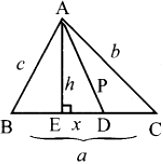
From the figure, D is the mid point of BC.
We have ∠AED = 90°
∴ ∠ADE < 90° and ∠ADC > 90°
i.e. ∠ADE is acute and ∠ADC is obtuse,
(i) In ΔADC, ∠ADC is obtuse angle.
AC2 = AD2 + DC2 + 2DC x DE
⇒ AC2 = AD2 + (1/2)BC2 + 2.(1/2)BC . DE
⇒ AC2 = AD2 + (1/4)BC2 + BC.DE
⇒ AC2 = AD2 + BC.DE + (1/4)BC2
⇒ b2 = p2 + ax + (1/4)a2
Hence proved.
(ii) In ΔABD, ∠ADE is an acute angle.
AB2 = AD2 + BD2 – 2BD.DE
⇒ AB2 = AD2 + ((1/2)(BC))2 – 2 x (1/2)BC.DE
⇒ AB2 = AD2 + (1/4)BC2 – BC.DE
⇒ AB2 = AD2 – BC.DE + (1/4)BC2
⇒ c2 = p2 – ax + (1/4)a2
Hence proved.
(iii) From (i) and (ii) we get .
AB2 + AC2 = 2AD2 + (1/2)BC2
i.e. c2 + b2 = 2p2 + (a2/2)
Hence it is proved.